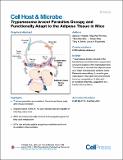Files in this item
Trypanosoma brucei parasites occupy and functionally adapt to the adipose tissue in mice
Item metadata
| dc.contributor.author | Trindade, Sandra | |
| dc.contributor.author | Rijo-Ferreira, Filipa | |
| dc.contributor.author | Carvalho, Tânia | |
| dc.contributor.author | Pinto-Neves, Daniel | |
| dc.contributor.author | Guegan, Fabien | |
| dc.contributor.author | Aresta-Branco, Francisco | |
| dc.contributor.author | Bento, Fabio | |
| dc.contributor.author | Young, Simon A. | |
| dc.contributor.author | Pinto, Andreia | |
| dc.contributor.author | Van Den Abbeele, Jan | |
| dc.contributor.author | Ribeiro, Ruy M. | |
| dc.contributor.author | Dias, Sérgio | |
| dc.contributor.author | Smith, Terry K | |
| dc.contributor.author | Figueiredo, Luisa M. | |
| dc.date.accessioned | 2016-06-09T10:30:04Z | |
| dc.date.available | 2016-06-09T10:30:04Z | |
| dc.date.issued | 2016-06-08 | |
| dc.identifier | 243024991 | |
| dc.identifier | a019b7cc-dbdd-41e1-819f-05de8aa678ce | |
| dc.identifier | 84969909575 | |
| dc.identifier | 000377447000014 | |
| dc.identifier.citation | Trindade , S , Rijo-Ferreira , F , Carvalho , T , Pinto-Neves , D , Guegan , F , Aresta-Branco , F , Bento , F , Young , S A , Pinto , A , Van Den Abbeele , J , Ribeiro , RM , Dias , S , Smith , T K & Figueiredo , LM 2016 , ' Trypanosoma brucei parasites occupy and functionally adapt to the adipose tissue in mice ' , Cell Host & Microbe , vol. 19 , no. 6 , pp. 837-848 . https://doi.org/10.1016/j.chom.2016.05.002 | en |
| dc.identifier.issn | 1931-3128 | |
| dc.identifier.other | RIS: urn:78C28EF176E4E4892D9111249D30AED9 | |
| dc.identifier.other | ORCID: /0000-0003-1072-905X/work/38796298 | |
| dc.identifier.uri | https://hdl.handle.net/10023/8957 | |
| dc.description | This work was supported by 55007419 (HHMI) and 2151 (EMBO) to L.M.F., D.P.-N., F.B., and F.G.; FCT fellowships to S.T., F.R.-F., and F.A.-B. (SFRH/BPD/89833/2012, SFRH/BD/51286/2010, and SFRH/BD/80718/2011, respectively); Wellcome Trust grant (093228), MRC MR/M020118/1, and European Community Seventh Framework Programme under grant agreement No. 602773 (Project KINDRED) to S.A.Y. and T.K.S.; and PAI 7/41 (Belspo) and ERC-NANOSYM to J.V.D.A. | en |
| dc.description.abstract | Trypanosoma brucei is an extracellular parasite that causes sleeping sickness. In mammalian hosts, trypanosomes are thought to exist in two major niches: early in infection, they populate the blood; later, they breach the blood-brain barrier. Working with a well-established mouse model, we discovered that adipose tissue constitutes a third major reservoir for T. brucei. Parasites from adipose tissue, here termed adipose tissue forms (ATFs), can replicate and were capable of infecting a naive animal. ATFs were transcriptionally distinct from bloodstream forms, and the genes upregulated included putative fatty acid β-oxidation enzymes. Consistent with this, ATFs were able to utilize exogenous myristate and form β-oxidation intermediates, suggesting that ATF parasites can use fatty acids as an external carbon source. These findings identify the adipose tissue as a niche for T. brucei during its mammalian life cycle and could potentially explain the weight loss associated with sleeping sickness. | |
| dc.format.extent | 13 | |
| dc.format.extent | 4863455 | |
| dc.language.iso | eng | |
| dc.relation.ispartof | Cell Host & Microbe | en |
| dc.subject | African trypanosomes | en |
| dc.subject | Fat | en |
| dc.subject | Mouse infection | en |
| dc.subject | Fatty acid β-oxidation | en |
| dc.subject | Metabolism | en |
| dc.subject | Transcriptome | en |
| dc.subject | QH301 Biology | en |
| dc.subject | BDC | en |
| dc.subject | R2C | en |
| dc.subject | SDG 3 - Good Health and Well-being | en |
| dc.subject.lcc | QH301 | en |
| dc.title | Trypanosoma brucei parasites occupy and functionally adapt to the adipose tissue in mice | en |
| dc.type | Journal article | en |
| dc.contributor.sponsor | European Commission | en |
| dc.contributor.sponsor | The Wellcome Trust | en |
| dc.contributor.sponsor | Medical Research Council | en |
| dc.contributor.institution | University of St Andrews. School of Biology | en |
| dc.contributor.institution | University of St Andrews. Biomedical Sciences Research Complex | en |
| dc.identifier.doi | 10.1016/j.chom.2016.05.002 | |
| dc.description.status | Peer reviewed | en |
| dc.identifier.grantnumber | 602773 | en |
| dc.identifier.grantnumber | 093228/Z/10/Z | en |
| dc.identifier.grantnumber | MR/M020118/1 | en |
This item appears in the following Collection(s)
Items in the St Andrews Research Repository are protected by copyright, with all rights reserved, unless otherwise indicated.

